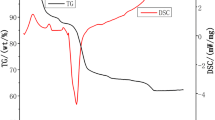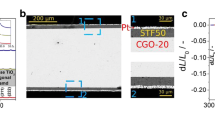Abstract
Here we discuss the effect of preparation conditions on structural stability and electrical properties of Sr-deficient n-type SrTiO3. In particular, an explanation of a wide scatter of conductivity values in Y- and Nb-doped SrTiO3. reported in the literature is proposed, based on the existing defect chemistry model of n-doped SrTiO3. It was confirmed that when sintered in air, Sr-deficient SrTiO3 doped with Nb and/or Y, remains single phase until the solubility limit (e.g., 30% for Nb or 4% for Y). However, when sintered at low po2, the material transforms from a vacancy compensated to an electronically compensated compound with a strontium deficient second phase. Measured at 800°C in low po2, the maximum conductivity of these multi-phase compounds was 340 S/cm and 100 S/cm for the Nb-doped and Y-doped sample, respectively. However, the conductivity dropped dramatically to less than 10 S/cm when samples of the same compositions were sintered in air, again measured in reducing atmosphere.
Similar content being viewed by others
References
S.J. Visco, C.P. Jacobson, I.Villareal, A. Leming,Y. Matus, and L.C. deJonghe, Electrochem. Soc. Proc., 2003-07, 1040 (2003).
G. Pudmich, W. Jugen, and F. Tiez,in 6-th Int. Solid Oxide Fuel Cell Symp., Electrochemical SocietyProceedings, edited by S.C Singhal and M. Dokiya (1999) vol. 99–19, p. 577.
P.R. Slater, D.P. Fagg, and J.T.S. Irvine, J.Mater. Chem., 7, 2495 (1997).
S. Hui and A. Petric, J. Electrochem. Soc., 149, J1(2002).
O.A. Marina, N.L. Canfield, and J.W. Stevenson, Solid State Ionics, 149, 21 (2002).
S. Koutcheiko, Y. Yoo, and A. Petric, in Proc. 5th European Solid Oxide FuelCell Forum, Lucerne (CH) (2002) vol. 2, p. 655.
S. Hui,Ph.D. Thesis, Evaluation of the n-doped for solid oxide fuelcell anode. McMaster University, Hamilton, Canada, 2000.
H.P.R. Frederikse, W.R. Hosler, W.R. Thurber, J. Babiskin, and P.G.Siebermann, Phys. Rev., 158, 775 (1967).
D.M. Eagles, in Physics of Disordered Materials, edited by D.Adler (Plenum, New York, 1985), p. 357.
R.Moos, S. Schöllhammer, and K.H.Härdtl, Appl. Phys. A, 65, 291 (1997).
P. Calvani, M.Capizzi, F. Donato, S. Lupi, P. Maselli, and D. Peschiaroli,Phys. Rev. B., 47, 8917 (1993).
R. Moos, A. Gnudi, and K.H. Härdtl,J. Appl. Phys., 78, 5042 (1995).
C. Lee, J. Destry, andJ.L. Brebner, Phys. Rev. B., 11, 2299 (1975).
D.A. Crandles, B. Nicholas, C. Dreher, C.C. Homes, A.W. McConnell, B.P.Clayman, W.H. Gong, and J.E. Greedan, Phys. Rev. B., 59, 12842 (1999).
F. Gervais, J.-L. Servoin, A. Baratoff, J.G. Bednorz, and G. Binnig,Phys. Rev. B., 47, 8187 (1993).
A.M.J.H. Seuter, Philips Res. Repts., 3(Suppl) 1 (1974).
R. Moos and K.H. Härdtl,J. Am. Ceram. Soc., 80, 2549 (1997).
D.M. Smyth, J.Electroceram., 9, 179 (2002).
R. Meyer and R. Waser, Sensors and Actuators B,101, 335 (2004).
M.J. Akhtar, Z-U-N Akhtar, R.A. Jackson, andC.R.A. Catlow, J. Am. Ceram. Soc., 78, 421 (1995).
R. Meyer, R. Waser, J. Helmbold, and G. Borchardt, J. Electroceramics., 9, 103 (2002).
J. Daniels and K.H. Härdtl, Philips Res. Repts., 31, 489 (1976).
U. Balachandran and N.G. Eror, J. Electrochem. Soc.,129, 1021 (1982).
R. Moos, T. Bischoff, W. Menesklou, and K.H. Härdtl,J. Mater. Sci., 32, 4247 (1997).
S.N.Ruddlesden and P.Popper,Acta Crystall., 11, 54 (1958).
P.D. Battle, J.E. Bennett, J. Sloan, R.J.D. Tilley, andJ.F. Vente, J. Solid State Chem., 149, 360 (2000).
W. Menesklou, H-J. Schreiner, K.H.Härdtl, and E. Ivers-Tiffée, Sensors and Actuators B, 59, 184 (1999).
T. Suzuki, Y. Nishi, and M Fujimoto,Philos. Mag. A, 80, 621 (2000).
M. Fujimoto and M. Watanabe,J. Mater. Sci., 20, 3683 (1985).
N.-H. Chan, R.K. Sharma, and D.M. Smyth,J. Electrochem. Soc., 128, 1762 (1981).
Author information
Authors and Affiliations
Corresponding author
Rights and permissions
About this article
Cite this article
Kolodiazhnyi, T., Petric, A. The Applicability of Sr-deficient n-type SrTiO3 for SOFC Anodes. J Electroceram 15, 5–11 (2005). https://doi.org/10.1007/s10832-005-0375-7
Received:
Revised:
Accepted:
Issue Date:
DOI: https://doi.org/10.1007/s10832-005-0375-7




